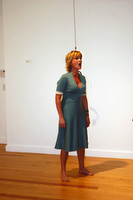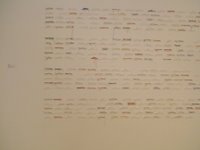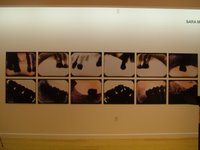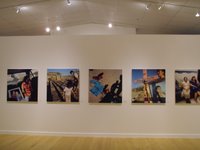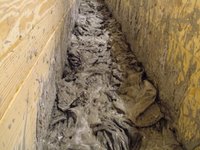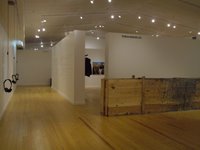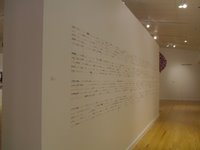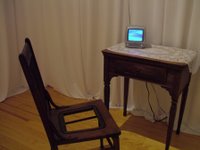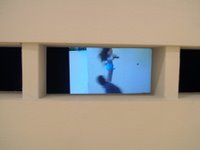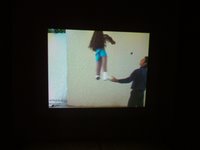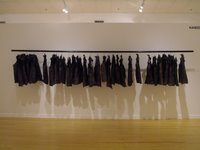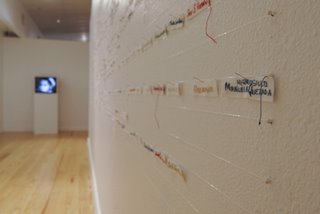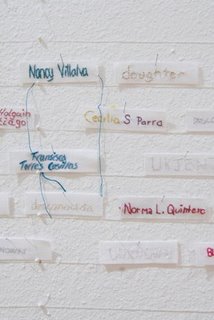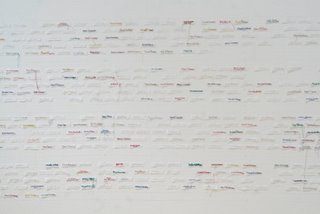I can't believe it is almost 2 months since I last updated the blog...that was not my plan..actually I had plans of updating daily as I installed....but I soon realized that I needed all my focus on installing and actually finished 3am, the night before the opening.
Where to start?
On the plain back to Norway after the opening I started to write thinking about the blog and everything I wanted to share with all of you that are part of this project.
Overall I think the exhibit
Frontera 450+ is an important and strong testemony and protest against the horror of femicides. The 17 artists invited, all contributed reflections on different angles of the situation. Rosalinda Gonzales and James Harithas installed and placed the works with so much thought. I think the viewer is led through the exhibtion and being confronted with the situation in Juàrez, in a strong but yet disturbing way. The commitment from all the staff and James Harithas at the Station Museum are so real, forceful and great. They want to make a change, they believe art has an important voice in doing so. And I think that is why they time after time makes such strong exhibits. I am really glad to have had the opportunity to work and be with all of them.
So to my contribution:
I'll start with the wall:
I installed the labels using Morse code. I translated the Mexican National Anthem into morse code, letting the dots be the unknown labels and the dashes be the identified names. The identified names were sorted using the year in which the bodies were found and identified. The morse code, which has traditionally been used as a universal language of need, has a designated space between the characters making up each letter, another between the letters and a third marking the space between the words. Overall, the work could be viewed with a cohesive rhythm, representing the Mexican Anthem. Due to the use of 5 lines within each verse, the work could also reference musical scores. As you come close to the wall, each individual name slowly appears. In this way the installation carries another level of meaning and protest. The anthem ends when the last woman identified as of this year, appears. This leaves the anthem unfinished, as it ends in the second chorus.
It was important for me that the installation would hold up and become more than a memorial , that it would connect to what had happened around the world in all the workshops.
I see this wall in the museum as a testimony to each woman, both the living and the dead. The viewer becomes a witness, connecting to the traces of each others existence. These multiple women’s traces are crossing symbolically over the surface as they connect to each other through the threads and fabric. Visually, the embroidered name, even the “unknown”, contains traces of the woman who embroidered. It is through her handwriting, her choice of colours and stitches that she leaves behind a trace of herself. I also believe the dead woman’s name has left a trace with the embroiderer through the time and care she had to use in order to embroider, while simultaneously hearing the stories of individual girls and women.
Installing the labels in this code was very time consuming, repetetive and medidative. When doing it, I realized I was continuing the embroidering. Somehow, each dot, each dash, was another way of stitching memory of the missing women began by you around the world.
On the opposing wall to the installation, I installed text, quates from what many of you have sent me, along with a list of all your names..totally 396 names so far, from more than 20 countries!
The response I have gotten to the installation has been very good and I feel that I have managed to create some of what I was hoping for.
Four of the mothers came from Juárez for the opening. I was thinking of them as I installed, wanting them to get the feeling of support and care that I felt each label held. They spent a long time in front of the installation. Finding their own daughters names, friends...10 mothers had participated in the project and embroidered their daughter's name as well.
I talked with them, trying to explain how it had been made, your quates were translated to them. It was hard though, because their reality is so cruel and hard and it so difficult to believe in how anything can help.... At the same time, knowing that you are supported and that people do care is an important step from the worst of all -being silenced and forgotten!
An art critic and writer wrote to me: "Your idea is simple and elegant, democratic and universal, and it provides an effective quiet moment in an exhibition in which many of the works seem to assault you for your attention. (That's not a criticism of the exhibit or the other work, just a comment on the volume level of some of the videos.) I loved the idea of using Morse code to give form to your installation, since the principal way anyone other than code enthusiasts thinks of Morse code is in terms of the international distress call, SOS. I'm also intrigued by your linking the names of these women to the Mexican national anthem...
Your piece (and, forgive me, I can't remember the title) formed a still, reflective pool in a strong and disturbing (in all the right ways) exhibit."
A review in Houston cronicle disussed the Exhibit and the installation.
The day after the opening there were a panel discussion about the situation in Juárez where all the mothers were given a chance to tell their story. Although I couldn't understand their words, I felt the total hopelessness of the situation and the fury they felt for being treated like waste from the governemt(my words)
I will write in a separete post more about this discussion, but my overall impression is the continuing need of attention. The Mexican government's new approach to deal with the situation is to pretend it has all been a myth!!
They use important PR companies abroad to help them make this cover up story. Our job is to believe and support the mothers and help them improve their situation.
Although embroidering the names is a small step, it is a step towards community and awareness. This has to be all for now. I am waiting for images of the exhibit to be sent to me. As soon as I have it I will post them , and send all of you by email as well.
THANKS!
Best Lise

